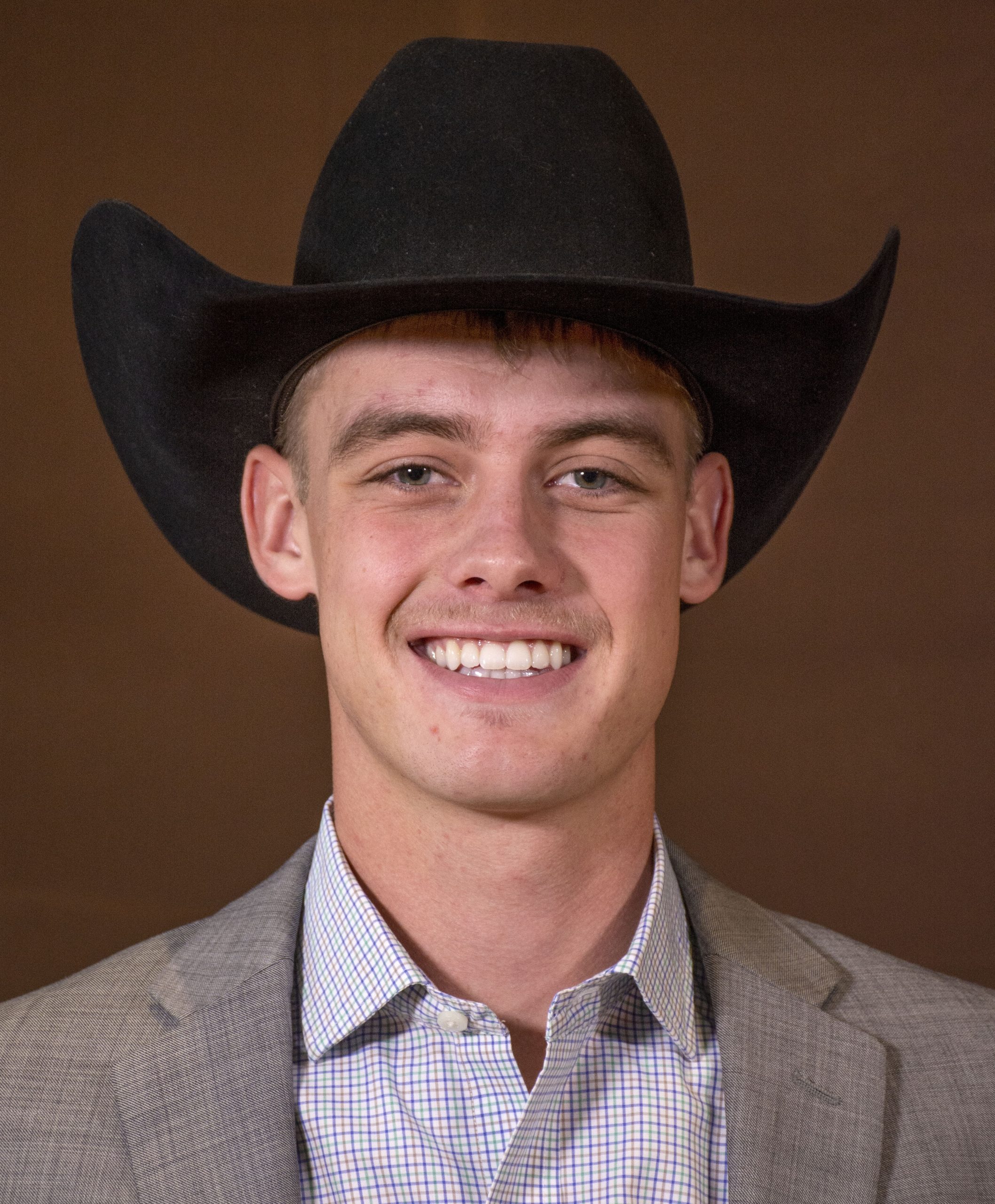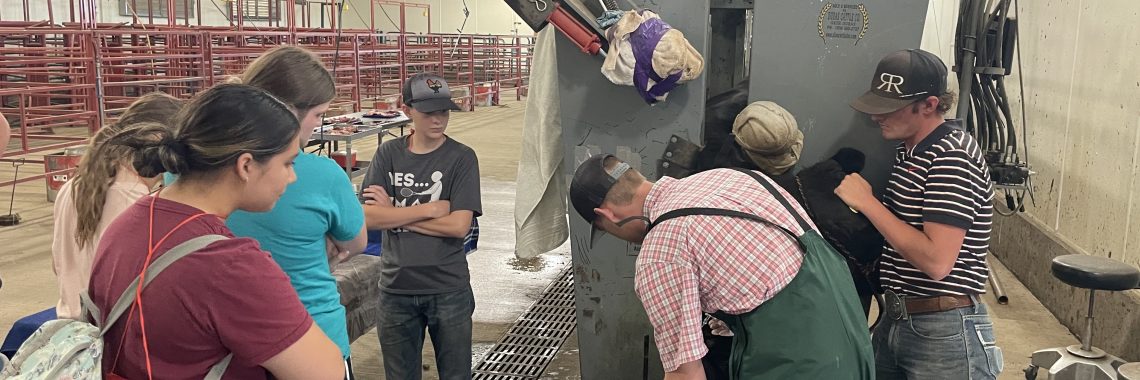In the cattle industry, AI usually means artificial insemination. But, for one groundbreaking UW scientist, AI in beef production also refers to artificial intelligence.
A native of Wheatland, Wyoming, PhD student Chase Markel has been involved in cattle production for as long as he can remember. It’s his heritage, his passion, and his primary area of study as a university researcher.
Congestive heart failure in cattle
Markel completed both his undergraduate and graduate degrees in the UW Department of Animal Science. As a master’s student, he studied pulmonary hypertension, also known as high-altitude disease or brisket disease, in cattle.

Through this research, Markel became especially interested in congestive heart failure, a condition that’s linked to pulmonary hypertension and has become a growing issue in finishing beef cattle.
“It’s a tricky disease, and there’s no easy solution,” he says. “The more that you learn, the more that you realize you don’t know.”
Markel’s research indicates that subclinical cases of pulmonary hypertension, in which an animal is affected by high-altitude disease but survives, may have larger economic impacts than direct profit losses incurred when an animal dies before harvest.
“The main economic impact of this disease likely is not just death loss, but more so the loss of these production efficiencies in terms of live animal growth performance, carcass quality, and then sensory attributes of the final beef product,” he explains.
The size and shape of a cow’s right ventricle is a telltale indicator of pulmonary hypertension and risk of congestive heart failure. As the disease causes increased pressure in the right ventricle, the muscle becomes increasingly thick and misshapen.
If Markel wanted to understand how risk factors associated with congestive heart failure affected beef production, he’d need to examine as many bovine hearts as possible.
Improving efficiency with AI
Tim Holt, a professor at Colorado State University and one of Markel’s close collaborators, had already developed a 1–5 scoring system to assess the risk of pulmonary hypertension. In Holt’s system, a score of 1 means the heart appears normal, while a heart with a score of 5 resembles a deflated volleyball.
Collecting this type of data typically involved hunching over the offal lines in a beef-processing plant, frantically categorizing the hearts zipping past. But, Markel wondered, what if the researchers could just take photos of the hearts and then train a computer to sort those images into the correct category?
As an animal scientist and lifelong cattle producer, Markel knew far more about artificial insemination than artificial intelligence. But, inspired by a conversation with anthropologist Sean Field, he decided to apply for a fellowship in UW’s School of Computing.
Field, an assistant professor in the School of Computing, had developed AI models to analyze satellite images for topographic features associated with ancient structures. If that was possible, Markel thought, maybe an AI model could be used to more efficiently detect bovine heart abnormalities.
At the time, he didn’t know what an image classification model was, let alone how to build one of his own. But, with the help of mentors in the School of Computing, Markel ultimately created an artificial intelligence model that uses heart images to evaluate the presence and severity of risk factors for congestive failure in cattle.
First, though, Markel painstakingly scored thousands of hearts by hand using photos taken in commercial processing plants in Nebraska and Colorado. To build the image classification tool he’d envisioned, Markel not only needed to create an AI model—something he’d never done before—but also train it to accurately score hearts.
Analyzing thousands of hearts
As a School of Computing fellow, Markel has fed nearly 1,000 scored heart images into the AI model he developed, training it to evaluate images using Professor Holt’s scoring system.

So far, the experiment has been a success. The model has already achieved 92% accuracy—in other words, given an image it’s never encountered before, the AI model assigns the correct score 92% of the time.
That’s an impressively high degree of accuracy, but Markel intends to continue refining the model. It might sound crazy, he admits, but his goal is to expand the dataset to 15,000 images. “There’s all types of shapes and sizes of hearts,” he says. “Things look very different in different plants with different lighting and different animals.”
While he’s pleased with the model’s performance, Markel acknowledges that the tool has limitations. It’s been trained solely on Markel’s image scores, which are inherently subjective. To strengthen the model, he’d need to train it using scores assigned by other researchers as well.
Still, Markel considers his work a successful proof of concept. “Hopefully someday somebody can actually use this in the industry,” he says.
Transforming data analysis in production ag
Production agriculture is a data-heavy industry, but sometimes the sheer volume of information can be unwieldy for both researchers and industry professionals.
Meat-processing plants, for example, are “really good at collecting data relevant to what services their bottom line, or has traditionally serviced their bottom line,” Markel comments.
But current systems don’t capture subclinical conditions, which may have economic implications for both plants and producers.
Once Markel has gotten a better idea of how many, and to what degree, cattle show signs of congestive heart failure risk, he hopes to determine how these risk categories interact with live animal performance, carcass quality, and other economically relevant factors.
“I think there’s a huge opportunity for these plants to incorporate either this image classification system or some [other] type of classification system into their pre-existing model,” he says. “I think this type of analysis could bring a lot of value in trying to pinpoint exactly which carcasses are adding value, which carcasses are not adding value, and is there some disease involvement there.”
While Markel’s current model is best suited for application in processing plants, he hopes that future iterations will benefit Wyoming producers more directly.
Producers themselves collect data every day, he points out. “They might do it on the back of a piece of notebook paper, but that data has a lot of value. What I’ve noticed in animal science and with producers around the state, is [that] we have so much data—and we rely on traditional methods to analyze these data.”
Those approaches have worked well for a long time, but Markel sees opportunities for researchers and producers to more effectively apply data with the assistance of AI models and machine learning.
“As researchers, we need to start incorporating those tools into our research and try to help build that technology so producers and people out in the industry can actually utilize those tools and help improve their bottom line,” he concludes.
This article was originally published in the 2025 issue of Roots & Ranges, an annual magazine published by the UW College of Agriculture, Life Sciences and Natural Resources.





